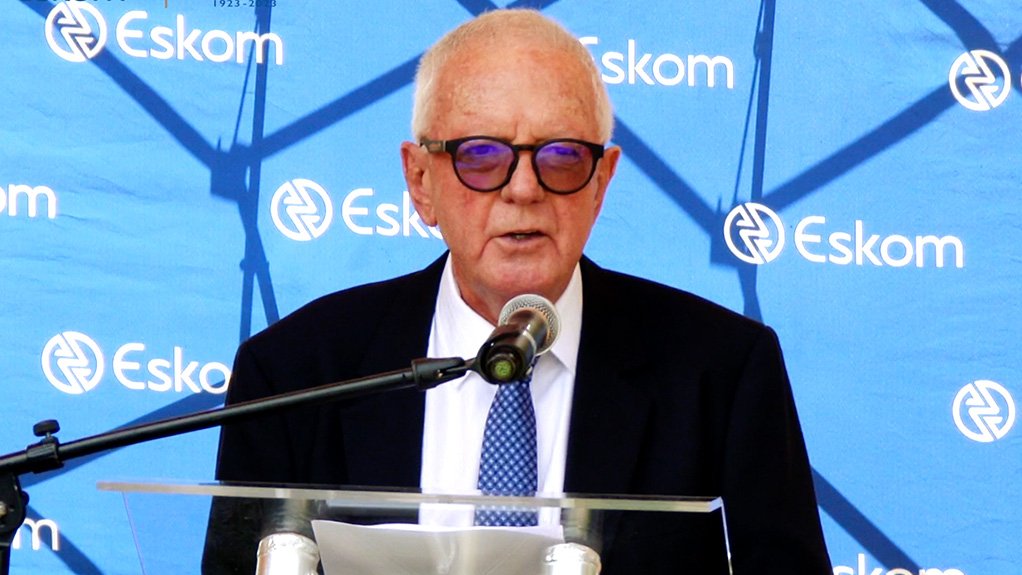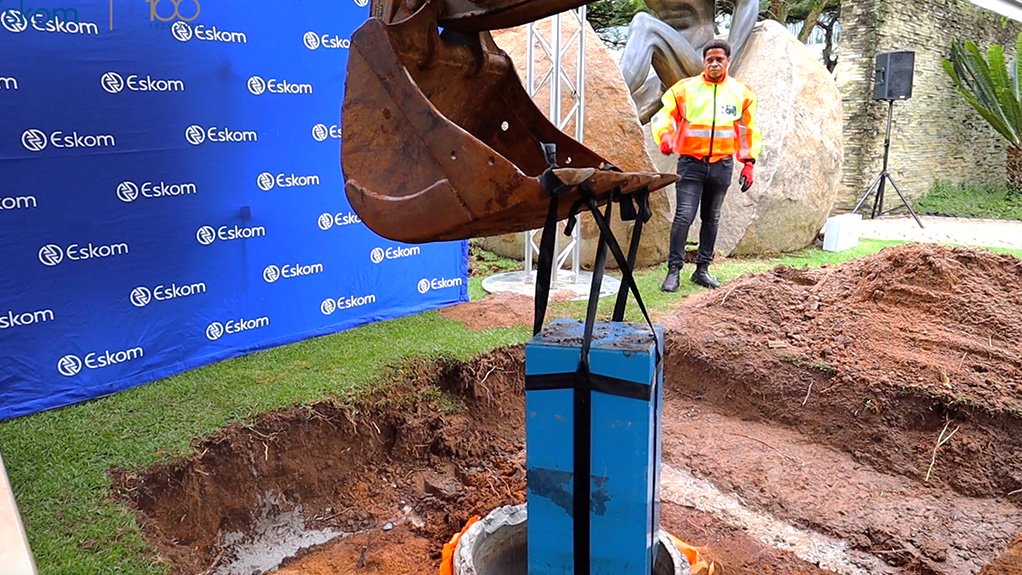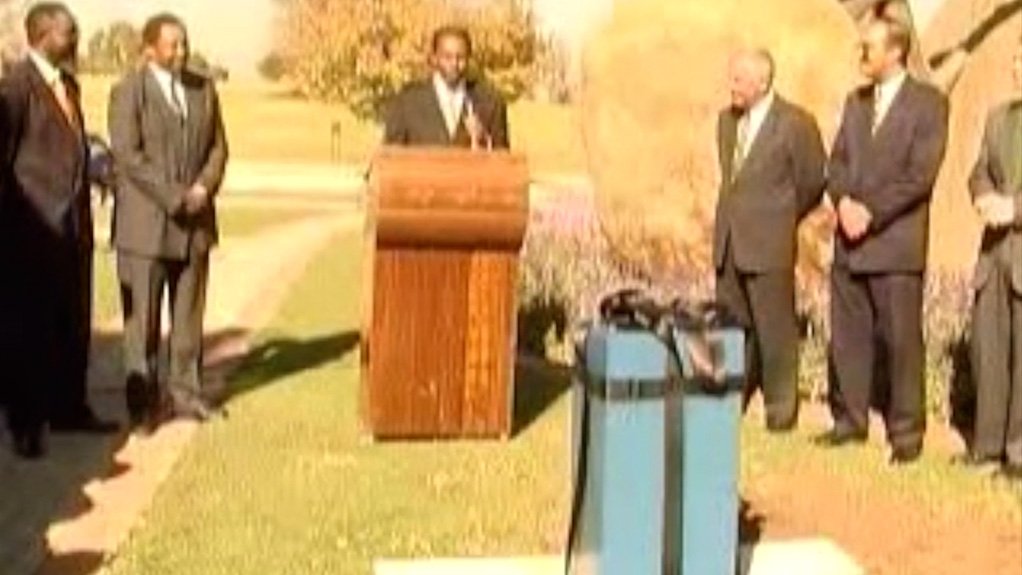- A copy of the letter penned by then Eskom CEO Allen Morgan in April 19990.19 MB
In his letter to the employees of Eskom of 2023, buried in a time capsule in 1999 near to the ‘rock man’ energy statue at the entrance of Megawatt Park, then CEO Allen Morgan highlighted two challenges facing the utility – challenges that subsequently morphed into serious problems that are now weighing heavily on an organisation that marked its hundredth birthday on March 1 with Stage 4 loadshedding.
The letter was unearthed together with the other contents of the time capsule at an event held at Megawatt Park on February 15 and attended by both Morgan and then CEO André de Ruyter.
De Ruyter exited the organisation only days later and a month ahead of his official departure date following the corporate and political fallout from his damning television interview with eNCA, during which he highlighted ongoing criminality at Eskom.
The first challenge outlined by Morgan was the growing problem of the non-payment for electricity, which he said had arisen as a result of a feeling that electricity should be given “for nothing”; an attitude that “obtains in the local government sector as well, with people refusing to pay rents and service fees”.
This challenge was indirectly amplified by one of the other contents of the rectangular stainless-steel container submerged in 1999: Eskom’s first-ever pre-payment meter.
In his Budget speech delivered a week after the Eskom ceremony, and which was dominated by the R254-billion Eskom debt-relief plan, Finance Minister Enoch Godongwana bemoaned the fact that municipalities owed Eskom R56.3-billion at the end of 2022 and that this debt was continuing to rise.
The second and even more crucial challenge highlighted by Morgan in his 1999 letter is the one now being felt daily by South Africans and reads as follows: “The next challenge is the question of generation capacity. Since the mid-1980s we have had a surplus of generation capacity that we have managed. We predict that this will have disappeared around 2007, but you know whether this prediction was accurate enough.”
In the event, the forecast contained in the letter turned out to be painfully precise, with the shortfall materialising in the first bouts of loadshedding in 2007.
The crisis was precipitated by policy, regulatory and governance failings that continue to haunt the country and Eskom, including a decision not to implement the 1998 White Paper and a warning that the procurement of new generation had to begin before the turn of the millennium if it was to be in place by 2007.
Morgan alluded to this at the time-capsule recovery ceremony in February, noting that in 1999 “we had 24 power stations and I don’t think you have many more today, which you should have had.”
Following years of policy malaise, government belatedly instructed Eskom to proceed with two mega coal projects simultaneously, following decades of construction inactivity and entirely inadequate front-end engineering and design.
This lack of preparedness and experience, coupled with deplorable corruption, have combined toxically to yield a build programme that is about a decade behind schedule and tremendously over budget.
Delays to the commissioning of the Medupi and Kusile units, together with a ‘keep the lights on’ policy, which initially coincided with preparations for the hosting of the 2010 FIFA World Cup, all but eradicated the time and space required to adequately maintain the existing coal fleet, some units of which effectively began decommissioning themselves.
The net effect has been a precipitous decline in the energy availability factor (EAF) of the coal fleet, which has decoupled entirely from another artefact contained in the time-capsule: a poster outlining the generation division’s performance, under the ‘90:7:3’ operational philosophy, where a 90% EAF was implement, together with 7% planned maintenance target and only 3% of unplanned breakdowns.
While the poster is perfectly preserved the 90:7:3 strategy has long been dead and buried, with no prospect of resurrection. Indeed, some suggest that it was not even sensible to begin with, as such an aggressive target was out of kilter with international norms for coal assets.
Indeed, there are only now serious efforts under way to reform Eskom to the twenty-first-century operational practices envisaged in the 1998 White Paper, including the vertical separation of the generation, transmission and distribution business.
In fact, De Ruyter used the occasion to call on the Eskom employees of 2023 to embrace these changes under way rather than hark “back to the future” or to be “bound by what prevailed a century ago”.
“Let’s embrace what is going to be our future 25 years from now, when we will have a very different Eskom,” De Ruyter pleaded.
Eskom reports that the items that were in the time capsule will be displayed at the Eskom Megawatt Park library as well as on the Eskom website under the ‘Heritage Section’.
“Eskom as a State entity is required to preserve its historical items as well as record all items of heritage and ensure that they are registered with the South African Heritage Resources Agency registry, therefore all these items will be on the Eskom heritage asset register,” the company said in response to an enquiry.
Despite De Ruyter’s departure, a video of the time capsule unveiling was shared with employees as part of the birthday celebration, along with recorded messages from employees.
Interim CEO Calib Cassim also used the occasion to thank all employees for being “part of Eskom story and encouraged them to recommit to ending loadshedding and restoring Eskom to a company to be proud of”.
EMAIL THIS ARTICLE SAVE THIS ARTICLE ARTICLE ENQUIRY
To subscribe email subscriptions@creamermedia.co.za or click here
To advertise email advertising@creamermedia.co.za or click here















